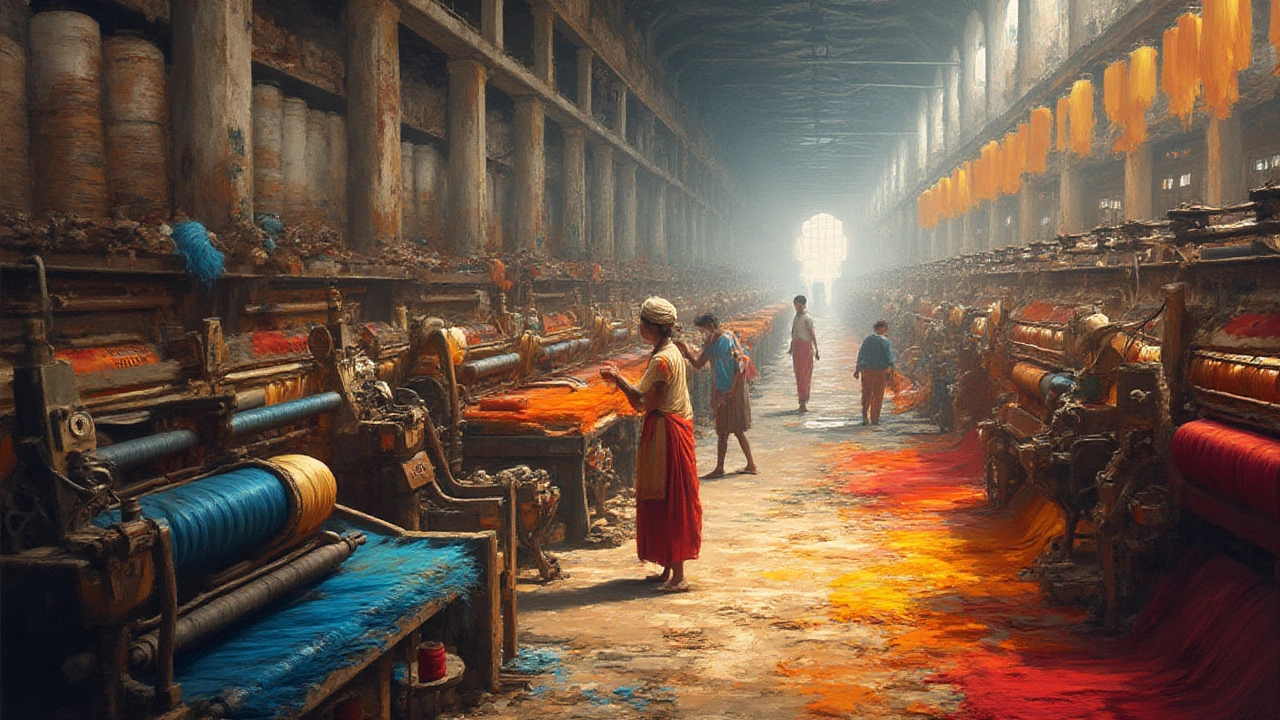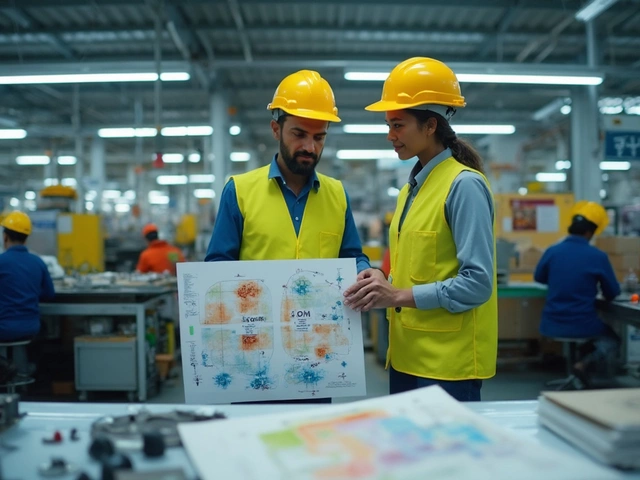The textile scene in India is a lot bigger—and more complex—than most people think. Picture this: every single day, factories across India turn out enough fabric to reach from Chennai to Delhi and then some. Yet, if you ask any entrepreneur whether a textile mill is still a smart investment today, the answers are rarely simple. The numbers paint a split picture. India’s textile and apparel exports hit $44.5 billion in 2024, up from $36.5 billion just five years ago. That's a massive jump. But the big question on every investor's mind: does all that action actually translate into reliable profits for new textile mills? Let's pull back the curtain on what it’s really like in 2025 to own and run a textile mill in India—and whether the payoff is worth the plunge.
How the Indian Textile Industry Sets the Stage for Profit
India isn’t known as “the world’s workshop” for nothing—textiles have fueled its local and export economy for centuries. Today, the textile sector contributes about 2.5% to the country’s GDP and gives jobs to over 45 million people directly. That’s more than Australia’s whole population, all spinning yarn or weaving fabric! But before you picture endless rows of ancient looms, it’s worth knowing that the game has changed. Mills aren’t just chasing low costs—they’re eyeing tech upgrades, eco-friendly processes, and specialty products that fetch a premium.
Let’s get specific. Cotton is still king: India is the world’s top cotton producer and the second largest exporter. This local resource keeps raw material costs down, which is a huge edge. But the latest trend? Demand for blended fibres (think poly-cotton shirts or viscose kurtis) has shot up by 20% since 2020. Domestic demand keeps climbing too—Indians now buy more ready-made clothes than ever, and exports go to over 150 countries. The lines at retail stores in places like Mumbai or Bengaluru after each festive season say it all—people want new, quality fabrics, fast.
Here’s a quick look at how the Indian textile machine churns out those numbers:
| Key Sector | Share in Export Revenue (2024) | Jobs Created |
|---|---|---|
| Cotton Textiles | 43% | 18 million |
| Man-made Fibre | 19% | 15 million |
| Silk & Wool | 7% | 6 million |
Government policies fuel this momentum. The PLI (Production Linked Incentive) scheme promises incentives worth over ₹10,600 crore ($1.3 billion) for new textile manufacturing setups, especially those making technical textiles or MMF (man-made fibre) goods. And if you’re willing to set up in states like Gujarat, Tamil Nadu, or Maharashtra, you’ll see extra perks: subsidized land, tax waivers, and help finding skilled workers. However, no government handout can outweigh poor planning or a lack of market insight. Real profit depends on understanding exactly where the value—and the risks—really are.
Breaking Down Costs and Yields: What a Textile Mill Owner Actually Deals With
No one’s dropping tens of crores on a new mill because it “sounds good.” You want to know the cost of entry and how long it’ll take to make that cash back. A modern spinning mill (let’s say 25,000 spindles) usually requires around ₹80–100 crore ($10–12 million) as an initial investment in 2025. That covers land, construction, machinery (like advanced Rieter or Truetzschler systems), and setting up utilities. Smaller powerloom units or fabric processing shops come cheaper, but the big money’s in scale, and international buyers want world-class quality.
Running costs aren’t small. Salaries take up about 22% of monthly outflows. Raw cotton or synthetic fibre prices are notorious for wild swings—cotton prices, for instance, have moved from ₹43,000 to ₹62,000 per candy (356 kg) in just three years. Electricity eats up another 18%. And here’s the kicker: Every ton of yarn or fabric needs massive water and energy—think factory-sized power bills. If you have unreliable supply (which is common in some areas), expect to spend more on generators and water treatment.
So why jump in at all? The margin. A well-run, efficient textile mill can clock EBITDA margins of 12-16% on average. The secret? Get your loading near full capacity, keep wastage below 2%, and grab bulk orders from big brands or exporters. Fail to fill up the order book, and you’re staring at long months chugging at half-throttle, bleeding cash. Smart mills now use ERP software and automated looms to cut manpower and slash losses—every rupee counts. Recycling waste (like cotton fly ash, defective cones) into lower-grade yarn or selling it as byproduct brings in extra rupees too.
The payback period, if you’re aggressive and lucky, is typically five to seven years for a full-sized mill. But miss a tech leap, or get stuck with old machinery, and your breakeven could drift out endlessly. Loan EMIs, especially after the Reserve Bank raised repo rates twice in 2023 and 2024, are a critical balance sheet figure. Those new to Indian banking might underestimate how much working capital you need for raw stocks and salaries, even with all the incentives floating around.

Obstacles and Hidden Risks in Indian Textile Mill Profitability
It’s not all sunshine and seamless exports. Even established mill owners worry about a mess of risks that can shred margins fast. The elephant in the room is global competition—countries like Bangladesh and Vietnam have wooed away western brands with even lower labour and power costs, and their free trade agreements give them duty-free access to big markets. This can leave Indian mills battling on thin margins, especially for basic products where price is everything.
Another headache? Labour. Mills may employ thousands, but skilled, reliable workers can be hard to find or keep, especially in remote areas. During the 2022–2023 migration wave, some Tamil Nadu mills saw absenteeism as high as 30%. Frustrated operators sometimes switch to automation—modern looms, automatic winders, etc.—but these upgrades demand big upfront spends, training costs, and sometimes face resistance from older staff.
Raw material volatility is a daily pain point. Any global event—drought hitting the Gujarat cotton crop, war jacking up oil prices (which means pricier polyester), Pakistan banning exports—turns up the heat. Hedging and forward contracts help, but the chance of getting caught off-guard is real. You’ll also deal with environmental controls. Water pollution, air emissions, and chemical use in dyeing and finishing processes all face much stricter RBI and state crackdowns now. Compliance means regular audits, reports, and sometimes costly upgrades to effluent treatment plants.
The environmental angle isn’t just regulatory—it’s a marketing factor. Western buyers now check for chemical-free dyes, sustainable practices, and ethical labour. Get blacklisted for violations once, and big buyers will ghost you, costing crores in lost orders. Every mill now chases certifications like OEKO-TEX and GOTS as a “must-have” badge.
Market access isn’t always a starry-eyed dream either. Many small and mid-sized mills work with a fickle chain of traders and bulk buyers whose payments don’t always land on time. Delays are common. Cash flow planning isn’t a side exercise—it’s a survival skill. GST compliance, fast-shifting tax rules, and local permit issues crop up more often than people admit. Add in the occasional political strike or transport bottleneck, and you have a lot of juggling to do beyond just churning out fabric.
Winning Strategies and Insider Tips for a Profitable Textile Mill in India
Now, here’s where experience matters. Profitable mills don’t just bet on producing “more”—they’re hyper-specific about their target market. Instead of competing as another t-shirt supplier, some new players carve out lucrative spaces in technical textiles (think fireproof uniforms, medical fabrics, industrial felts) or sustainable, organic cotton goods. These niches fetch 30–50% higher prices and enjoy loyal repeat buyers—much less risky than playing commodity volume games.
Don’t overlook the impact of digital. Top-performing mills have shifted part of their marketing to online B2B portals and social media, scooping small-batch orders globally that used to be locked away. A well-made website in 2025, with real-time inventory and QR-coded traceability for buyers, can mean direct orders from Europe or Australia (yes, people like me, based in Sydney, buy from India for specific products). Smart back-end systems let owners track everything from wastage to late payments or machine breakdowns at a glance.
Another inside tip? Diversify raw material sources. Don’t put all your bets on one crop or one supplier. Many successful mills lock in cotton or polyester contracts with both private ginners and state cooperatives. Some tap into recycled PET or upcycled textile waste streams—lower cost, plus a great green marketing angle. Logistics matter too. Mills with access to major ports, like those in Gujarat or Andhra Pradesh, save big on export transit times and charges.
Keep your staff skilled and satisfied. Rotating workers across different machines, offering skills upgrades, and making sure housing and medical support are robust can bring absenteeism way down and team spirits up. The best-run mills in 2025 treat their workforce as long-term investments, not just monthly wage expenses.
- Go for energy efficiency wherever possible: LED lighting, solar panels, and VFD-controlled motors now deliver triple-digit savings annually.
- Automate quality control—adding smart cameras or IoT sensors on looms catches fabric defects early, slashing costly rework and waste.
- Court export buyers with sustainability: Spend upfront on certifications (like GRS or ISO 14001) to unlock premium-paying customers.
- Join local and national textile park clusters for resource pooling, collective bargaining, and easier access to export infrastructure.
- Take full advantage of government incentives. Stay glued to ministry portals for new schemes—deadlines are real and funds dry up fast when released.
Spending smart on technology and building resilient supplier and sales networks can tip the odds in your favour. A profitable textile mill in India is neither a lottery ticket nor a sure-shot gold mine. But with careful planning, rock-solid execution, and a willingness to adapt fast, the rewards are very much there for the taking. If you’re looking to make your mark where tradition meets high-growth industry, and ready for a challenge that keeps you hustling every single day, there’s no place quite like it.





